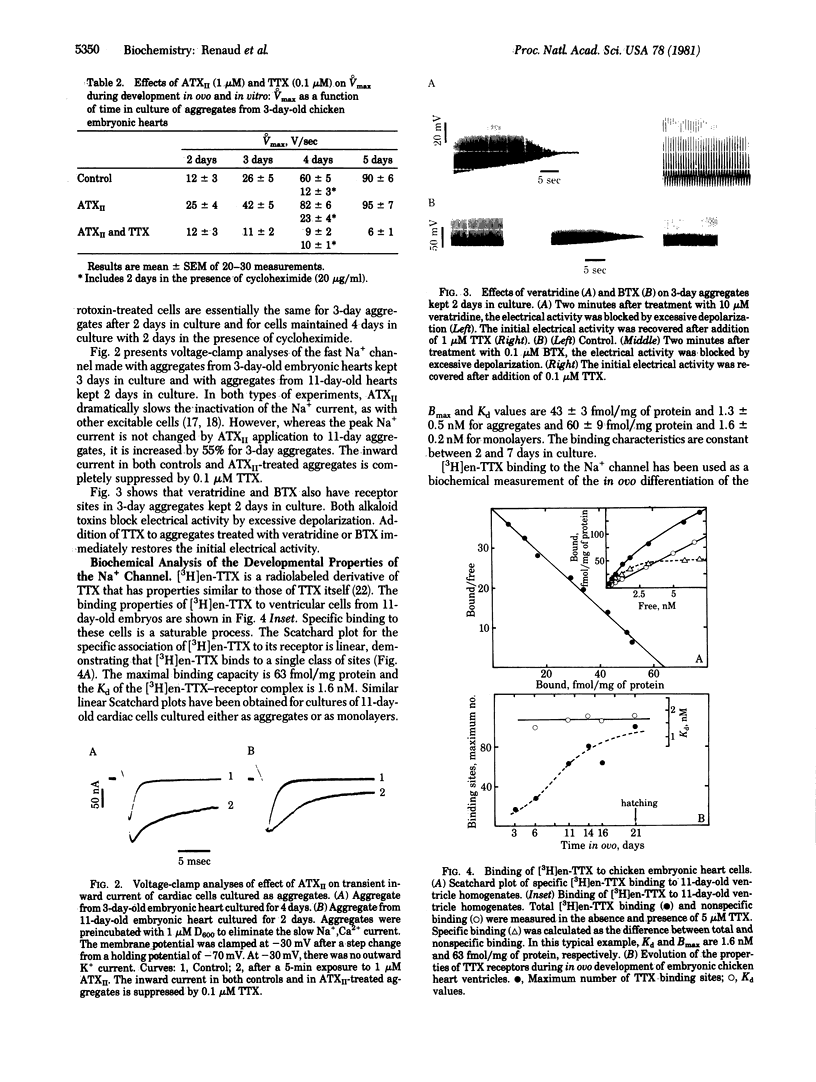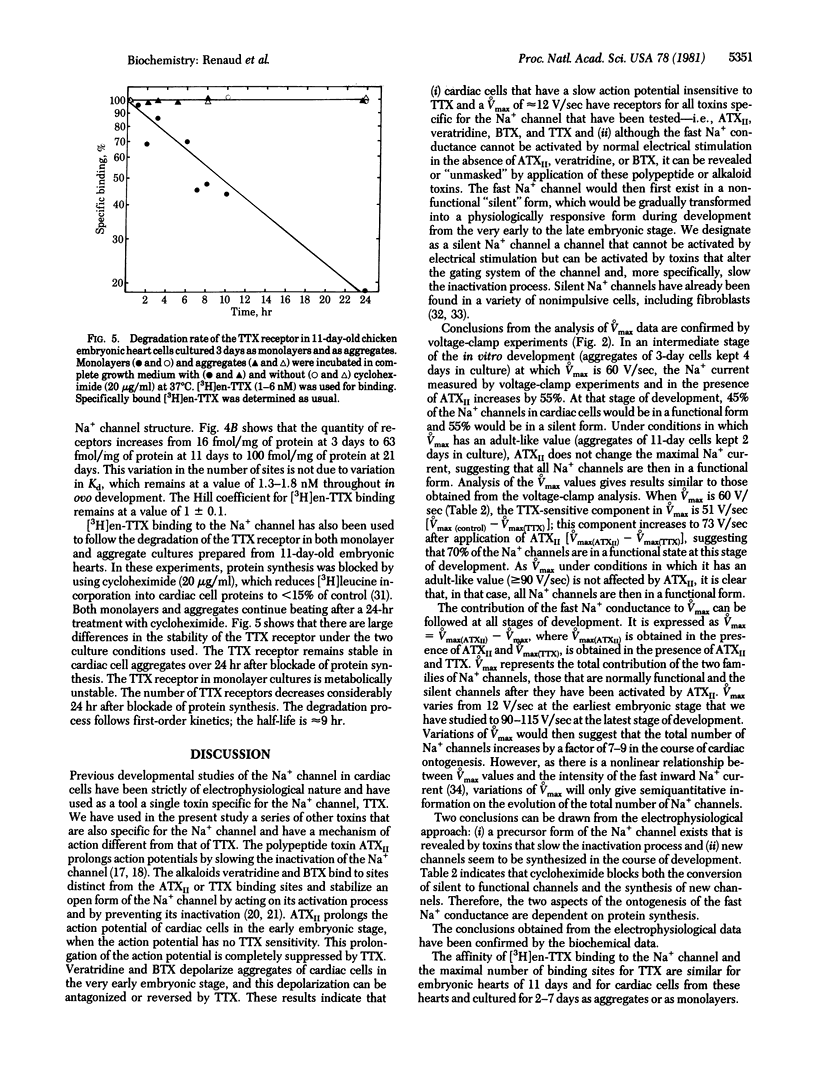Abstract
The sensitivity of embryonic cardiac cells to tetrodotoxin (TTX) increases with age. At the early embryonic stage, the maximum upstroke velocity is not affected by the presence of TTX. In the course of both in ovo and in vitro development, this velocity reaches an adult-like value of 90-120 V/sec, which is decreased in the presence of TTX to 5-10 V/sec. The differentiation of the Na+ channel has been followed by using three types of specific toxins: (i) TTX or a tritiated derivative of it, (ii) a polypeptide toxin extracted from sea anemone, and (iii) the alkaloidic toxins veratridine and batrachotoxin. Electrophysiological, including voltage-clamp experiments, and biochemical studies have shown (i) that the TTX receptor and the fast Na+ channel machinery exist even when action potentials are insensitive to TTX--the channel is then in a nonfunctional or silent form that is revealed (or chemically activated) by both the alkaloids and the polypeptide toxin--and (ii) that the total number of Na+ channels increases during development by a factor of 4 or 5. In monolayers of cardiac cells insensitive to TTX in which all Na+ channels are in a nonfunctional form, the rate of degradation of the TTX receptor follows first-order kinetics with a half-time of 9 hr. In aggregates fully sensitive to TTX, the number of TTX receptors remains perfectly stable 24 hr after blockade of protein synthesis.
Full text
PDF




Images in this article
Selected References
These references are in PubMed. This may not be the complete list of references from this article.
- Atkins G. L. A simple digital-computer program for estimating the parameters of the hill equation. Eur J Biochem. 1973 Feb 15;33(1):175–180. doi: 10.1111/j.1432-1033.1973.tb02667.x. [DOI] [PubMed] [Google Scholar]
- Bergman C., Dubois J. M., Rojas E., Rathmayer W. Decreased rate of sodium conductance inactivation in the node of Ranvier induced by a polypeptide toxin from sea anemone. Biochim Biophys Acta. 1976 Nov 11;455(1):173–184. doi: 10.1016/0005-2736(76)90162-0. [DOI] [PubMed] [Google Scholar]
- Béress L., Béress R. Purification of three polypeptides with neuro- and cardiotoxic activity from the sea anemone Anemonia sulcata. Toxicon. 1975 Nov;13(5):359–367. doi: 10.1016/0041-0101(75)90196-8. [DOI] [PubMed] [Google Scholar]
- Béress L., Béress R., Wunderer G. Isolation and characterisation of three polypeptides with neurotoxic activity from Anemonia sulcata. FEBS Lett. 1975 Feb 15;50(3):311–314. doi: 10.1016/0014-5793(75)80517-5. [DOI] [PubMed] [Google Scholar]
- Chicheportiche R., Balerna M., Lombet A., Romey G., Lazdunski M. Synthesis of new, highly radioactive tetrodotoxin derivatives and their binding properties to the sodium channel. Eur J Biochem. 1980 Mar;104(2):617–625. doi: 10.1111/j.1432-1033.1980.tb04466.x. [DOI] [PubMed] [Google Scholar]
- Ebihara L., Shigeto N., Lieberman M., Johnson E. A. The initial inward current in spherical clusters of chick embryonic heart cells. J Gen Physiol. 1980 Apr;75(4):437–456. doi: 10.1085/jgp.75.4.437. [DOI] [PMC free article] [PubMed] [Google Scholar]
- Fosset M., De Barry J., Lenoir M. C., Lazdunski M. Analysis of molecular aspects of Na+ and Ca2+ uptakes by embryonic cardiac cells in culture. J Biol Chem. 1977 Sep 10;252(17):6112–6117. [PubMed] [Google Scholar]
- Hartree E. F. Determination of protein: a modification of the Lowry method that gives a linear photometric response. Anal Biochem. 1972 Aug;48(2):422–427. doi: 10.1016/0003-2697(72)90094-2. [DOI] [PubMed] [Google Scholar]
- Iijima T., Pappano A. J. Ontogenetic increase of the maximal rate of rise of the chick embryonic heart action potential. Relationship to voltage, time, and tetrodotoxin. Circ Res. 1979 Mar;44(3):358–367. doi: 10.1161/01.res.44.3.358. [DOI] [PubMed] [Google Scholar]
- Kohlhardt M., Bauer B., Krause H., Fleckenstein A. Differentiation of the transmembrane Na and Ca channels in mammalian cardiac fibres by the use of specific inhibitors. Pflugers Arch. 1972;335(4):309–322. doi: 10.1007/BF00586221. [DOI] [PubMed] [Google Scholar]
- Lombet A., Renaud J. F., Chicheportiche R., Lazdunski M. A cardiac tetrodotoxin binding component: biochemical identification, characterization, and properties. Biochemistry. 1981 Mar 3;20(5):1279–1285. doi: 10.1021/bi00508a036. [DOI] [PubMed] [Google Scholar]
- McDonald T. F., Sachs H. G., DeHaan R. L. Development of sensitivity to tetrodotoxin in beating chick embryo hearts, single cells, and aggregates. Science. 1972 Jun 16;176(4040):1248–1250. doi: 10.1126/science.176.4040.1248. [DOI] [PubMed] [Google Scholar]
- McDonald T. F., Sachs H. G. Electrical activity in embryonic heart cell aggregates. Developmental aspects. Pflugers Arch. 1975;354(2):151–164. doi: 10.1007/BF00579945. [DOI] [PubMed] [Google Scholar]
- McLean M. J., Sperelakis N. Retention of fully differentiated electrophysiological properties of chick embryonic heart cells in culture. Dev Biol. 1976 May;50(1):134–141. doi: 10.1016/0012-1606(76)90073-7. [DOI] [PubMed] [Google Scholar]
- Nathan R. D., DeHaan R. L. In vitro differentiation of a fast Na+ conductance in embryonic heart cell aggregates. Proc Natl Acad Sci U S A. 1978 Jun;75(6):2776–2780. doi: 10.1073/pnas.75.6.2776. [DOI] [PMC free article] [PubMed] [Google Scholar]
- Pappano A. J. Action potentials in chick atria. Increased susceptibility to blockade by tetrodotoxin during embryonic development. Circ Res. 1972 Sep;31(3):379–388. doi: 10.1161/01.res.31.3.379. [DOI] [PubMed] [Google Scholar]
- Pouysségur J., Jacques Y., Lazdunski M. Identification of a tetrodotoxin-sensitive Na+ channel in a variety in fibroblast lines. Nature. 1980 Jul 10;286(5769):162–164. doi: 10.1038/286162a0. [DOI] [PubMed] [Google Scholar]
- Renaud D., Le Douarin G. Mise en évidence, par l'emploi d'inhibiteurs, d'une évolution des perméabilités membranaires cardiaques aux jeunes stades du dévelopment chez l'embryon de poulet. C R Acad Sci Hebd Seances Acad Sci D. 1972 Jan 17;274(3):418–421. [PubMed] [Google Scholar]
- Renaud J. F., Barhanin J., Cavey D., Fosset M., Lazdunski M. Comparative properties of the in ovo and in vitro differentiation of the muscarinic cholinergic receptor in embryonic heart cells. Dev Biol. 1980 Jul;78(1):184–200. doi: 10.1016/0012-1606(80)90328-0. [DOI] [PubMed] [Google Scholar]
- Renaud J. F., Sperelakis N. Electrophysiological properties of chick embryonic hearts grafted and organ cultured in vitro. J Mol Cell Cardiol. 1976 Nov;8(11):889–900. doi: 10.1016/0022-2828(76)90071-7. [DOI] [PubMed] [Google Scholar]
- Reuter H. Divalent cations as charge carriers in excitable membranes. Prog Biophys Mol Biol. 1973;26:1–43. doi: 10.1016/0079-6107(73)90016-3. [DOI] [PubMed] [Google Scholar]
- Romey G., Abita J. P., Schweitz H., Wunderer G., Lazdunski Sea anemone toxin:a tool to study molecular mechanisms of nerve conduction and excitation-secretion coupling. Proc Natl Acad Sci U S A. 1976 Nov;73(11):4055–4059. doi: 10.1073/pnas.73.11.4055. [DOI] [PMC free article] [PubMed] [Google Scholar]
- Romey G., Jacques Y., Schweitz H., Fosset M., Lazdunski M. The sodium channel in non-impulsive cells. Interaction with specific neurotoxins. Biochim Biophys Acta. 1979 Sep 21;556(2):344–353. doi: 10.1016/0005-2736(79)90053-1. [DOI] [PubMed] [Google Scholar]
- Romey G., Renaud J. F., Fosset M., Lazdunski M. Pharmacological properties of the interaction of a sea anemone polypeptide toxin with cardiac cells in culture. J Pharmacol Exp Ther. 1980 Jun;213(3):607–615. [PubMed] [Google Scholar]
- Rougier O., Vassort G., Garnier D., Gargouil Y. M., Coraboeuf E. Existence and role of a slow inward current during the frog atrial action potential. Pflugers Arch. 1969;308(2):91–110. doi: 10.1007/BF00587018. [DOI] [PubMed] [Google Scholar]
- Shigenobu K., Sperelakis N. Development of sensitivity to tetrodotoxin of chick embryonic hearts with age. J Mol Cell Cardiol. 1971 Dec;3(3):271–286. doi: 10.1016/0022-2828(71)90046-0. [DOI] [PubMed] [Google Scholar]
- Sperelakis N., Lehmkuhl D. Insensitivity of cultured chick heart cells to autonomic agents and tetrodotoxin. Am J Physiol. 1965 Oct;209(4):693–698. doi: 10.1152/ajplegacy.1965.209.4.693. [DOI] [PubMed] [Google Scholar]
- Ulbricht W. The effect of veratridine on excitable membranes of nerve and muscle. Ergeb Physiol. 1969;61:18–71. doi: 10.1007/BFb0111446. [DOI] [PubMed] [Google Scholar]
- de Barry J., Fosset M., Lazdunski M. Molecular mechanism of the cardiotoxic action of a polypeptide neurotoxin from sea anemone on cultured embryonic cardiac cells. Biochemistry. 1977 Aug 23;16(17):3850–3855. doi: 10.1021/bi00636a021. [DOI] [PubMed] [Google Scholar]




